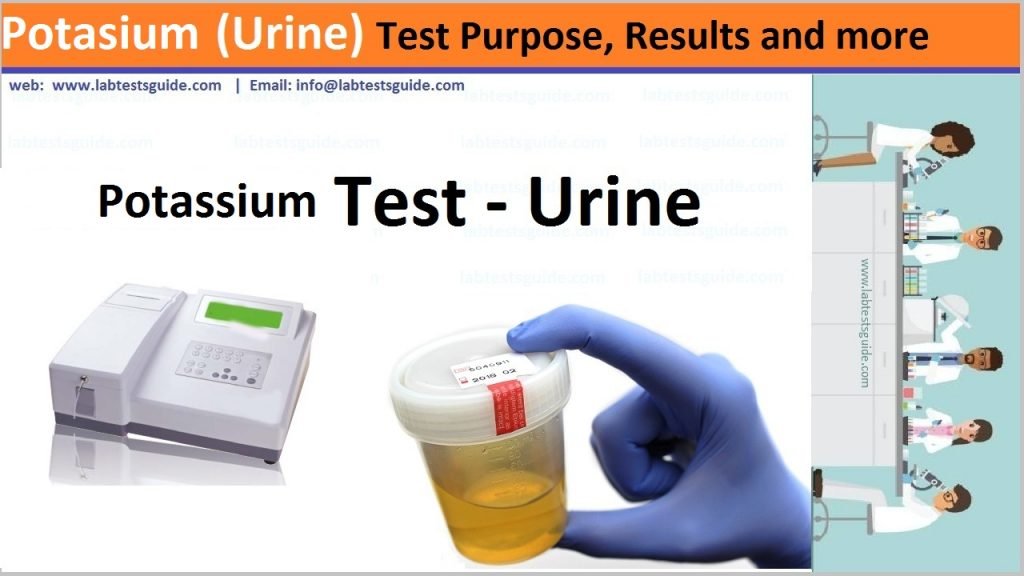A potassium urine test checks the level of potassium in your body. Potassium is an important element in cell metabolism, and it’s important in maintaining the balance of fluids and electrolytes in your body. Having too much or too little potassium can be bad. Getting a urine test to determine the amount of potassium in your body can help you alter your potassium levels for better overall health. Read New Article
A urinalysis is a test of your urine. A urinalysis is used to detect and manage a wide range of disorders, such as urinary tract infections, kidney disease and diabetes.
A urinalysis involves checking the appearance, concentration and content of urine. Abnormal urinalysis results may point to a disease or illness.

Also Known as: Urine Test, Urine Analysis , Urine CE, Urine C/E, UCE, Urinalysis
Test Panel: Physical properties, Chemical Tests, Dipstick Tests, Microscopic Examination
Type of urine samples:
- Random sample:
This is a diluted urine sample and may give an inaccurate interpretation of patient health. But is best to do microscopy to evaluate WBC or RBC. - First Morning sample:
This is the best sample for microscopy and urine analysis. This is the concentrated urine because of urine remained throughout the night in the urinary bladder. This will contains an increased concentration of analytes and cellular elements. Urine must have remained in the bladder for 8 hours is considered as the first-morning sample. - Urine for sugar (Postprandial 2 hours):
Postprandial 2 hours sample collected after 2 hours of high carbohydrate diet. - Midstream clean catch urine:
This sample is needed for the culture and sensitivity of urinary infection. The patient is advised to clean the urethra, then discard the first few mL of urine. Now midstream of the urine is collected in the sterile container. - 24 Hours of a urine sample
- In this case, discard the first urine and note the time.
- Now collect urine in the container for 24 hours and put the last sample in the container.
- Refrigerate the sample.
- This 24 hours samples are needed for measuring urea, creatinine, sodium, potassium, glucose, and catecholamines.
- Suprapubic collection of the urine sample:
This is done in the patients who cannot be catheterized and the sample is needed for culture. This sample is collected by the needle. - Catheter collection of urine:
This is done by patients who are bedridden and can not urinate. - Pediatric urine sample:
In infants, special collection bags are made adherent around the urethra. Then urine is transferred to a container.
Urine Potassium
A potassium urine test checks the level of potassium in your body. Potassium is an important element in cell metabolism, and it’s important in maintaining the balance of fluids and electrolytes in your body.
Why Get Tested:
Your doctor may order a potassium urine test to help diagnose certain conditions, including:
- hyperkalemia or hypokalemia
- kidney disease or injury, such as medullary cystic kidney disease
- adrenal gland problems, such as hypoaldosteronism and Conn’s syndrome
In addition, your doctor can use a potassium urine test to:
- check your potassium levels if you’ve been vomiting, had diarrhea for several hours or days, or shown signs of dehydration
- verify a high or low blood potassium test result
- monitor possible side effects of medications or drug treatments
Hyperkalemia
Having too much potassium in your body is called hyperkalemia. It can cause:
- nausea
- fatigue
- muscle weakness
- abnormal heart rhythms
If undetected or untreated, hyperkalemia can be dangerous and possibly even fatal. It’s not always detected before it causes symptoms.
Hypokalemia
Too little potassium in your body is called hypokalemia. A severe loss or drop in potassium can cause:
- weakness
- fatigue
- muscle cramps or spasms
- constipation
Sample Required:
- Collect 24 hours urine.
- Procedure to collect 24-hour urine: Discard the first sample and note the time.
- Collect the rest of the urine for 24 hours and urinate the last sample into the container.
- Refrigerate the urine during collection.
Normal Range:
Values vary with diet.
| Age | meq/day |
|---|---|
| 6 to 10 years | |
| Male | 17 to 54 |
| Female | 8 to 37 |
| 10 to 14 years | |
| Male | 22 to 57 |
| Female | 18 to 58 |
| Adult | 25 to 125 |
Causes of high or low potassium levels
Hyperkalemia is most likely caused by acute kidney failure or chronic kidney disease. Other causes of high potassium levels in urine include:
- acute tubular necrosis
- eating disorders, such as anorexia and bulimia
- other kidney diseases
- low blood magnesium levels, called hypomagnesaemia
- lupus
- medicines, such as antibiotics, blood thinners, nonsteroidal anti-inflammatory drugs (NSAIDs), and blood pressure medication like angiotensin II receptor blockers (ARBs) or angiotensin-converting enzyme (ACE) inhibitors
- renal tubular acidosis
- excessive use of diuretics or potassium supplements
- type 1 diabetes
- alcoholism or heavy drug use
- Addison’s disease
A low level of potassium in your urine may be caused by:
- adrenal gland insufficiency
- eating disorders, such as bulimia
- excessive sweating
- excessive laxative use
- magnesium deficiency
- certain medicines, including beta blockers and nonsteroidal anti-inflammatory drugs (NSAIDs), water or fluid pills (diuretics), and some antibiotics
- excessive vomiting or diarrhea
- excessive alcohol use
- folic acid deficiency
- diabetic ketoacidosis
- chronic kidney disease
Related Articles:
Possible References Used







